TwinMOS Technologies WBBRP1 MINI PCI WIRELESS LAN CARD User Manual MANUAL
TwinMOS Technologies Inc. MINI PCI WIRELESS LAN CARD MANUAL
MANUAL
TwinMOS Booming
802.11b
Wireless LAN Card
User’s Manual
TwinMOS®

Booming
TwinMOS Page 1
Contents
PACKAGE CONTENTS……........................................................2
INTRODUCTION..........................................................................3
WIRELESS NETWORK OVERVIEW............................................4
BOOMING WIRELESS NETWORK SCENARIOS………..6
INSTALLATION FOR LINUX .................................................................................9
INSTALLATION FOR WINDOWS.............................................…..11
CONFIGURATION UTILITY....................................................…..19
TROUBLESHOOTING....................................................…..27
TECHNICAL SPECIFICATIONS.......................................…..28
FCC CAUTION ................…………………………………………………..........…..39

Booming
TwinMOS Page 2
PACKAGE CONTENTS
Unpack your Booming WLAN Card kit and verify that all items are present.
Booming Wireless LAN card
User’s Manual (on CD)
Driver (on CD)
If any of the items described appear to be damaged or missing, please contact your reseller.

Booming
TwinMOS Page 3
INTRODUCTION
The Booming WLAN Card is a wireless network client that complies with the IEEE 802.11b standard
on wireless LANs. The IEEE 802.11b standards compliance means this adapter gives you the flexibility
to connect it to any 802.11b network. The IEEE 802.11b Ethernet standard allows you to connect
computers and devices at speeds up to 11Mbps, dependent upon the distance between wireless adapters,
the configuration of your working environment, or the capabilities or limitations of your computer
systems.
This Booming WLAN Card supports following WLAN features:
Automatic transmit data rate select mechanism in the transmit range of 1, 2, 5.5 and 11 Mbps.
Center frequency channel selection (2.4 GHz)
Roaming over multiple channels.
Supports power save mode
Support TKIP and AES advanced WLAN security
128-bit Wired Equivalent Privacy (WEP) data encryption.
This Booming WLAN card comes with software drivers for the most popular Microsoft Windows
operating systems and can be integrated into a larger network, running Windows XP, Windows 2000,
Windows ME, or Windows 98 in either Ad-Hoc mode or infrastructure mode. This manual provides a
quick introduction to wireless technology and its application as it relates to networking. Take a moment
to read through this manual and familiarize you with wireless technology. You should also give
yourself some time to become familiar with your new wireless network.

Booming
TwinMOS Page 4
WIRELESS NETWORK OVERVIEW
A wireless local area network (LAN) is a flexible data communications system implemented as an
extension to, or as an alternative for, a wired LAN. Using radio frequency (RF) technology, wireless
LANs transmit and receive data over the air, minimizing the need for wired connections. Thus, wireless
LANs combine data connectivity with user mobility.
A local area network that transmit and receive over the air typically in an unlicensed frequency such as
the 2.4GHz band. A wireless LAN does not require lining up devices for line of sight transmission like
IrDA. Wireless access points (base stations) are connected to an Ethernet hub or server and transmit a
radio frequency over an area of several hundred to a thousand feet which can penetrate walls and other
nonmetal barriers. Roaming users can be handed off from one access point to another like a cellular
phone system. Laptops use wireless modems that plug into an existing Ethernet port or that are self
contained on PC cards, while stand-alone desktops and servers use plug-in cards (ISA, PCI, etc.).
Wireless LANs offer the following productivity, convenience, and cost advantages over traditional wired
networks:
Mobility - WLAN provide LAN users to access data in any location within the operating range of the
WLAN. Ad-hoc management decisions based on real-time information can significantly improve worker
efficiency.
Installation Speed and Simplicity - Installing a wireless LAN system can be fast and easy and can
eliminate the need to pull cable through walls and ceilings.
Installation Flexibility - Wireless technology allows the network to go where wire cannot go.
Reduced Cost-of-Ownership - While the initial investment required for wireless LAN hardware can
be higher than the cost of wired LAN hardware, overall installation expenses and life-cycle costs can be
significantly lower. Long-term cost benefits are greatest in dynamic environments requiring frequent
moves and changes.
Scalability - Wireless LAN systems can be configured in a variety of topologies to meet the needs of
specific applications and installations. Configurations are easily changed and range from peer-to-peer
networks suitable for a small number of users to full infrastructure networks of thousands of users that
enable roaming over a broad area.
Installation Considerations
Designed to go up to 300 feet (100 meters) indoors and up to 900 feet (273 meters) outdoors, Booming
WLAN card lets you access your network from virtually anywhere you want. Keep in mind, however,
that the number and thickness of walls, ceilings or other objects that the wireless signals must pass thru
may limit range. Typical ranges vary depending on the types of materials and background RF noise in
your home or business. The key to maximizing range is to follow these basic principles:

Booming
TwinMOS Page 5
Keep the number of walls and ceilings between the access point and your receiving device to a minimum
- Each wall or ceiling can reduce your TwinMOS Booming Wireless product’s range from 3-90 feet
(1-30 meters.) For some businesses or for a large residential home deployment, it may be more
beneficial to have more than one access point with overlapping coverage.
1. Be aware of the direct line between Access Points, Residential Gateways, and Computers - A wall
that is 1.5 feet thick (.5 meters), at a 45-degree angle appears to be almost 3 feet (1 meter) thick. At
a 2-degree angle it looks over 42 feet (14 meters) thick! Try to make sure that the Access Points and
Adapters are positioned so that the signal will travel straight through a wall or ceiling for better
reception.
2. Building Materials make a difference - A solid metal door or aluminum studs may have a negative
effect on range. Try to position Access Points, Residential Gateways, and Computers so that the
signal passes through drywall or open doorways and not other materials.
3. Make sure that the antenna is positioned for best reception by using the software signal strength
tools included with your product.
4. Keep your product away (at least 3-6 feet or 1-2 meters) from electrical devices that generate RF
noise, like microwaves, monitors, electric motors, etc.
For the average residence, range should not be a problem. If you experience low or no signal strength in
areas of your home that you wish to access, consider positioning the Access Point in a location directly
between the Residential Gateways and/or Computers that will be connected. Additional Access Points
can be connected to provide better coverage in rooms where the signal does not appear as strong as
desired.
Using radio frequency (RF) technology, WLANs transmit and receive data over the air, minimizing the
need for wired connections. Thus, WLANs combine data connectivity with user mobility, and, through
simplified configuration, enable movable LANs.
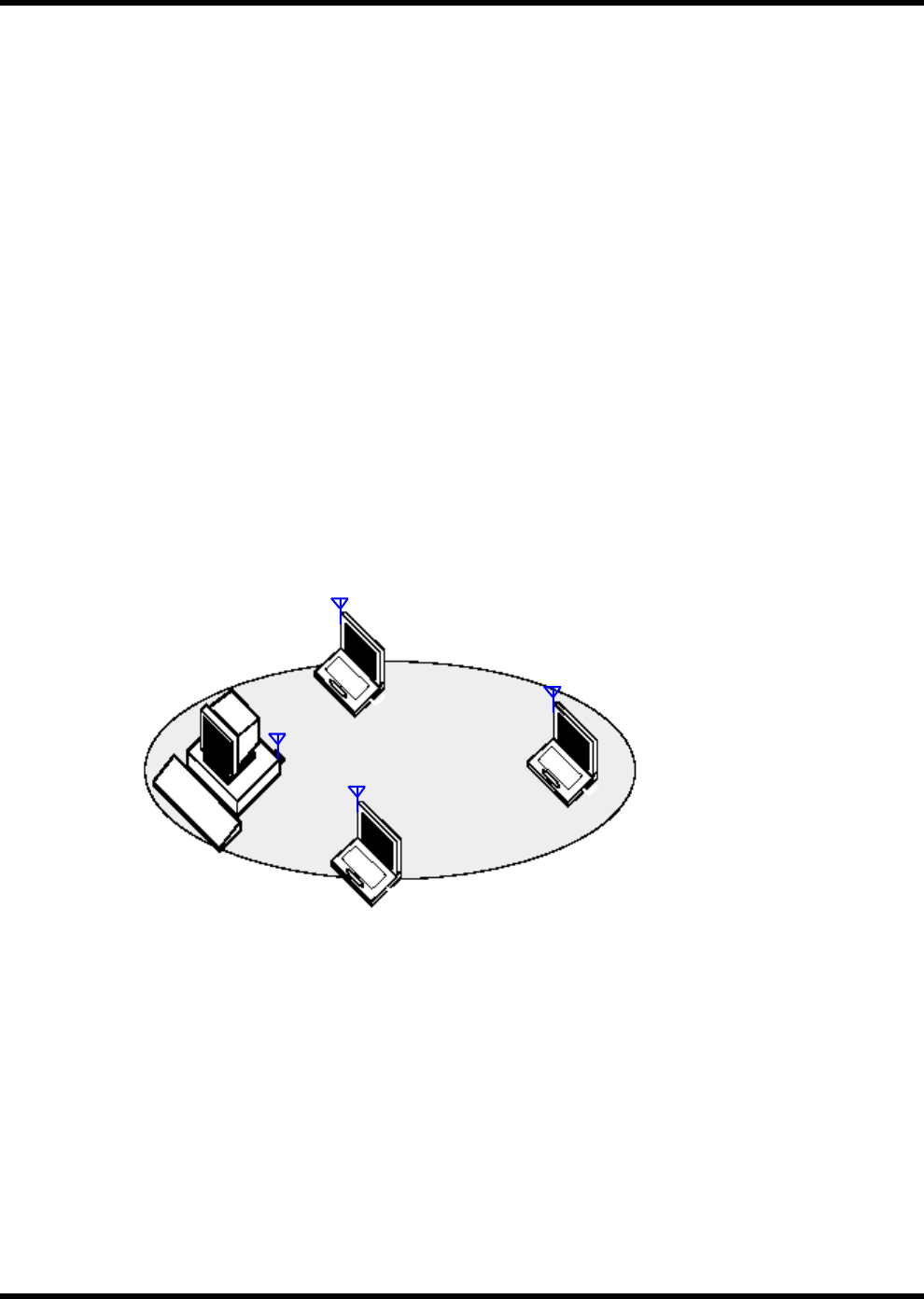
Booming
TwinMOS Page 6
Booming WIRELESS NETWORK SCENARIOS
The Booming WLAN Card enables you to:
Connect your computer to a Ad-Hoc workgroup of wireless computing devices (see Figure 1-1 on
page 7).
Connect your computer to a Small Office/Home Office (SOHO) network that includes a Residential
Gateway (RG) access point (see Figure 1-2 on page 8).
Connect your computer to a Local Area Network (LAN) Infrastructure that includes Access Points, or
other IEEE 802.11 compliant LAN systems (see Figure 1-3 and Figure 1-4).
Expand the capabilities of your Access Points, to support wireless devices that have been equipped
with Booming WLAN Card .
Ad-Hoc Workgroup
The Ad-Hoc workgroup configuration enables you to quickly set up a small wireless workgroup, where
the workgroup participants can exchange files using features like “Files and Printer Sharing” as
supported by Microsoft Networking.
Figure 1-1 Ad-Hoc Wireless Workgroup
You can use this option to setup a temporary or ad-hoc network in environments where no access points
are available (for example in Small Office/Home Office (SOHO) environments). As long as the stations
are within range of one another, this is the easiest and least expensive way to set up a wireless network.
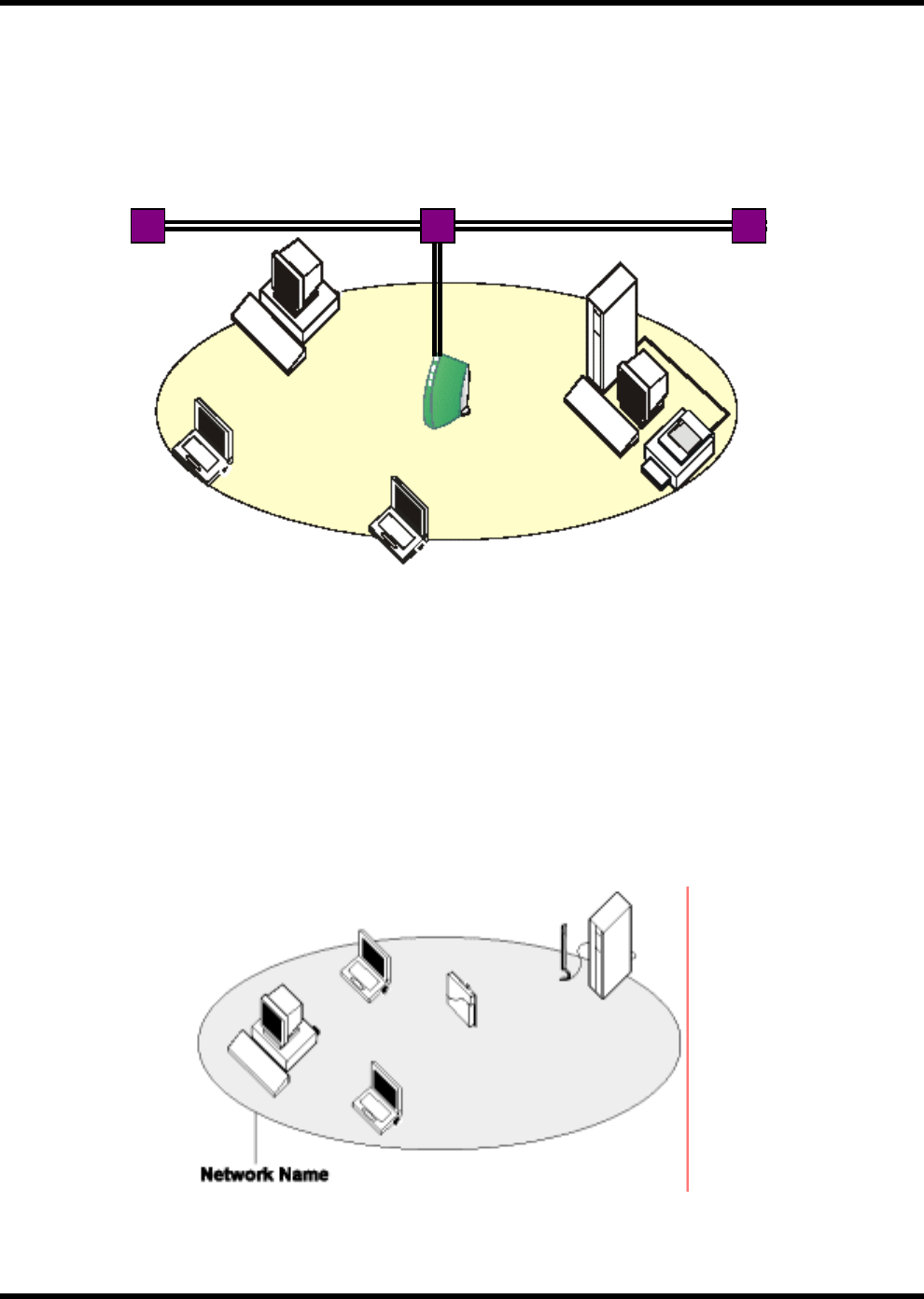
Booming
TwinMOS Page 7
Home Networking
With the TwinMOS Booming WLAN card, wireless access to the Internet or other computers is at your
fingertips. All you need to do is connect the wireless computers to an external cable, an xDSL or a ISDN
modem and you are ready to:
Share files and printers, and
Access the Internet
Figure 1-2 Connect to a Residential Gateway (RG)
Enterprise Networking
With the 11 Mbps Wireless LAN access point you can connect to a corporate Local Area Network (LAN)
infrastructure to have wireless access to all network facilities. LAN Infrastructures may either be:
Stand-alone wireless LANs (Figure 1-3).
Wireless network infrastructures connected to an existing Ethernet network (Figure 1-4).
Figure 1-3 Stand Alone Wireless LAN
xDSL
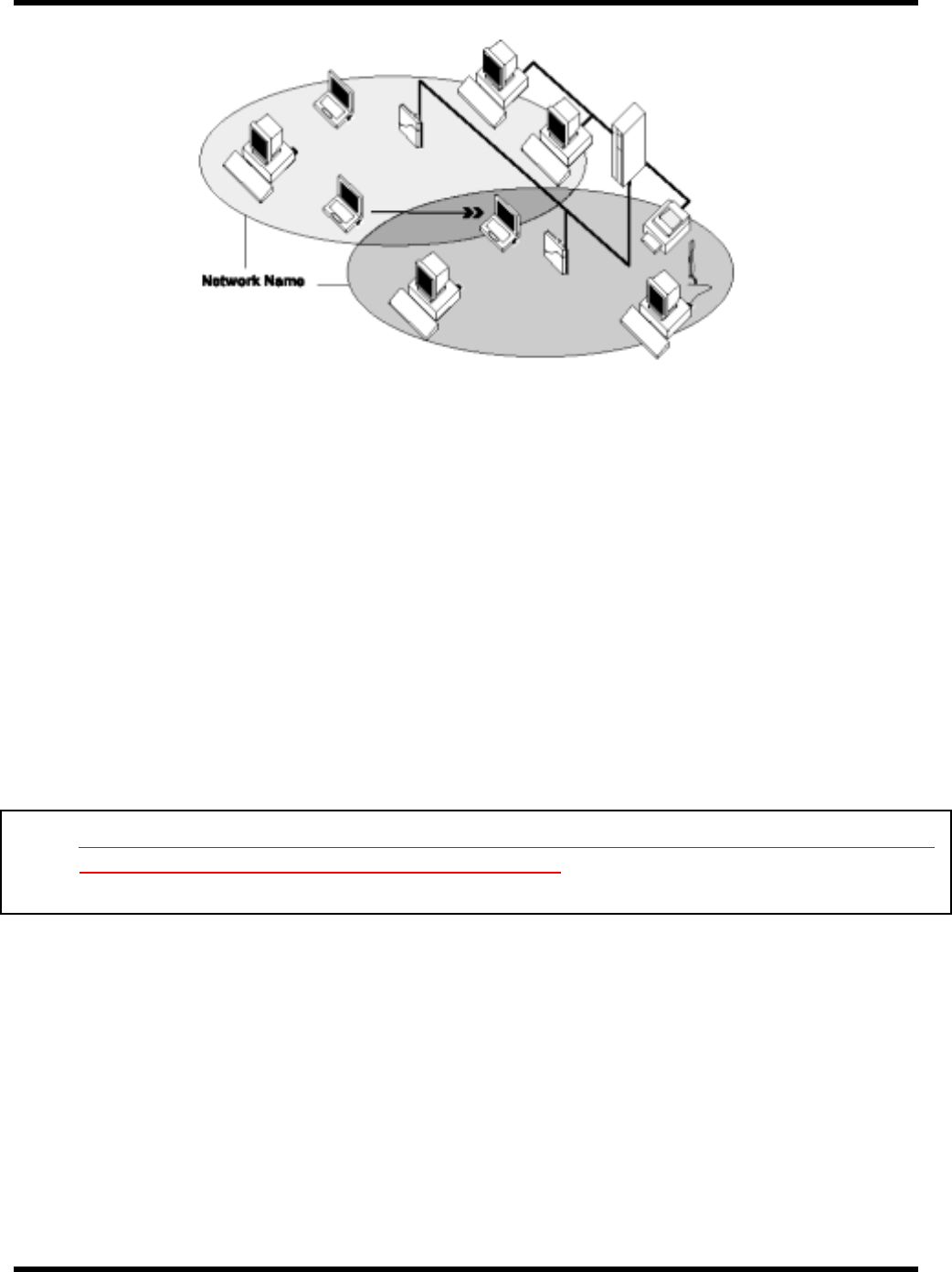
Booming
TwinMOS Page 8
Figure 1-4 LAN Infrastructure
It’s Easy
The Booming WLAN Card functions like any standard wired Ethernet card, but Booming WLAN
Card does not need any wires!
Where an Ethernet card requires a cable connection to a hub and/or patch panel, the cable physically ties
you down to the location of the wired connection.
Booming WLAN Card allows you to connect your computer to a Local Area Network (LAN) system
from anywhere within the wireless coverage area. Expanding or re-designing your network is easy: Add
or relocate access point, power-up your (new) wireless computers, and you’re done!
Unlike Ethernet, TwinMOS Booming WLAN Card will enable you to roam throughout the network
while remaining connected to the LAN.
Note
:
The Booming WLAN Card is a radio product. Refer to the flyer ”Information to the User” for
regulatory information that may apply in your country.

Booming
TwinMOS Page 9
INSTALLATION FOR LINUX
Content:
rh71/booming_rh71.o Booming driver for RedHat 7.1
rh72/booming_rh72.o Booming driver for RedHat 7.2
rh73/booming_rh73.o Booming driver for RedHat 7.3
rh80/booming_rh80.o Booming driver for RedHat 8.0
Procedure:
1 WLAN NIC up
1.1 Load module
ex:
/sbin/insmod booming_yourRedHatversion.o
1.2 Enable wireless lan driver
ex:
/sbin/iwpriv wlan0 enable
1.3 Set SSID
ex:
/sbin/iwpriv wlan0 wlan_para ssid=<your_ap_ssid>
1,4 Configure wlan0 IP address
ex:
/sbin/ifconfig wlan0 <your_ip_address> netmask <your_subnetmask> up
1.5 Test configuration
ex:
ping another_ip_address
2 WLAN NIC down
2.1 Shut down wlan0 net interface
/sbin/ifconfig wlan0 down
2.2 Disable wireless lan driver
/sbin/iwpriv wlan0 disable

Booming
TwinMOS Page 10
2.3 Unload module
/sbin/rmmod booming_rh73.o
Appendix
1.Print help message of wireless LAN specific parameters:
ex:
iwpriv wlan0 wlan_para help
FQA
Q1.I can't find 'iwpriv' command
A1:Please rpm file:wireless-tools-xx-x.i386.rpm.
And then man iwpriv for more detail.

Booming
TwinMOS Page 11
INSTALLATION FOR WINDOWS
The following section will assist you to install Booming WLAN Card successfully. You will plug in the
Booming WLAN card and then install driver firstly , and finally set the network properties to
accommodate resource sharing and select the type of wireless network that you want to install.
In order to establish your wireless network connection, make sure some steps below will be performed.
■ Install the Access Point (AP) at first if you use Access Point network mode.
■ Plug in the Booming wireless LAN card.
■ Install the driver using the Installation CD.
■ Install the network protocol(s) required to communicate on your network. Most likely you will
need the TCP/IP protocol.
The Booming Wireless LAN Configuration Utility is installed by executing the “Setup.exe” file. Note
also that some versions of Microsoft Windows operating systems require administrator to install
software. If this is the case for your operating system, be sure that you have such privileges before
executing the Setup.exe file. To upgrade an existing driver, it is not necessary to remove your Booming
driver from your computer. Simply run the Setup.exe file to replace the existing driver with the latest
version. After the new driver is installed, maybe you must restart the operating system (depend on the
Windows’ OS).
Please follow the following steps one by one in order to install the Booming WLAN Card
successfully.
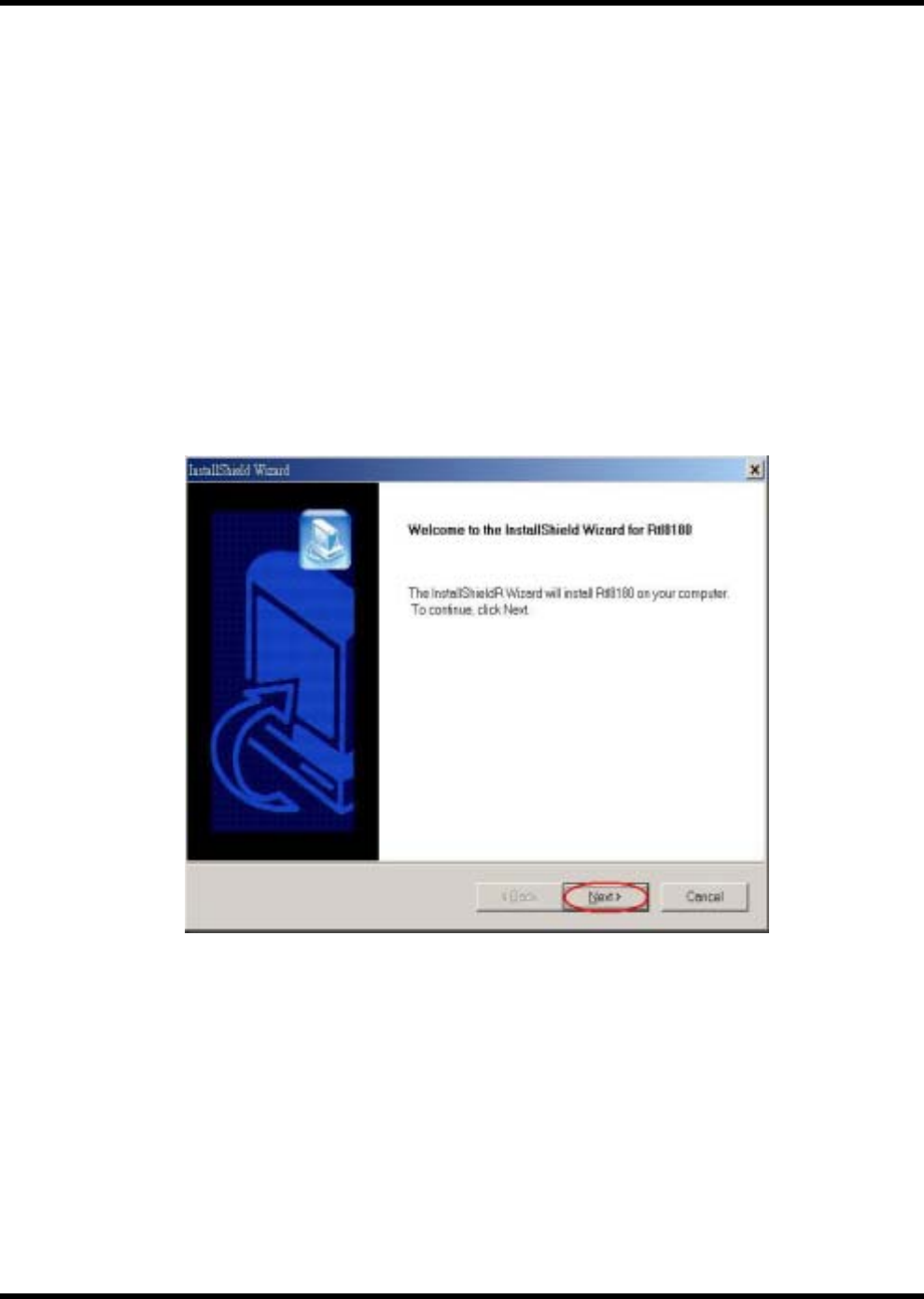
Booming
TwinMOS Page 12
For Windows 98SE/ME2000
Before you proceed with the installation, please notice following descriptions.
Note: The following installation was operated under Windows 2000. (Procedures will be the same for
Windows 98SE/Me.)
Install the Driver
1. Insert the Booming WLAN Card into the slot of your computer, the system will automatically find
the device and search for its driver.
2. Please select the “Win2000” folder (select the folder based on your computer’s OS system) and the
system will complete the driver installation automatically.
Install the Utility
1. Insert the CD into the CD-ROM device and execute the "Setup.exe" program. The InstallShield
Wizard box will appear, click "Next" to continue.
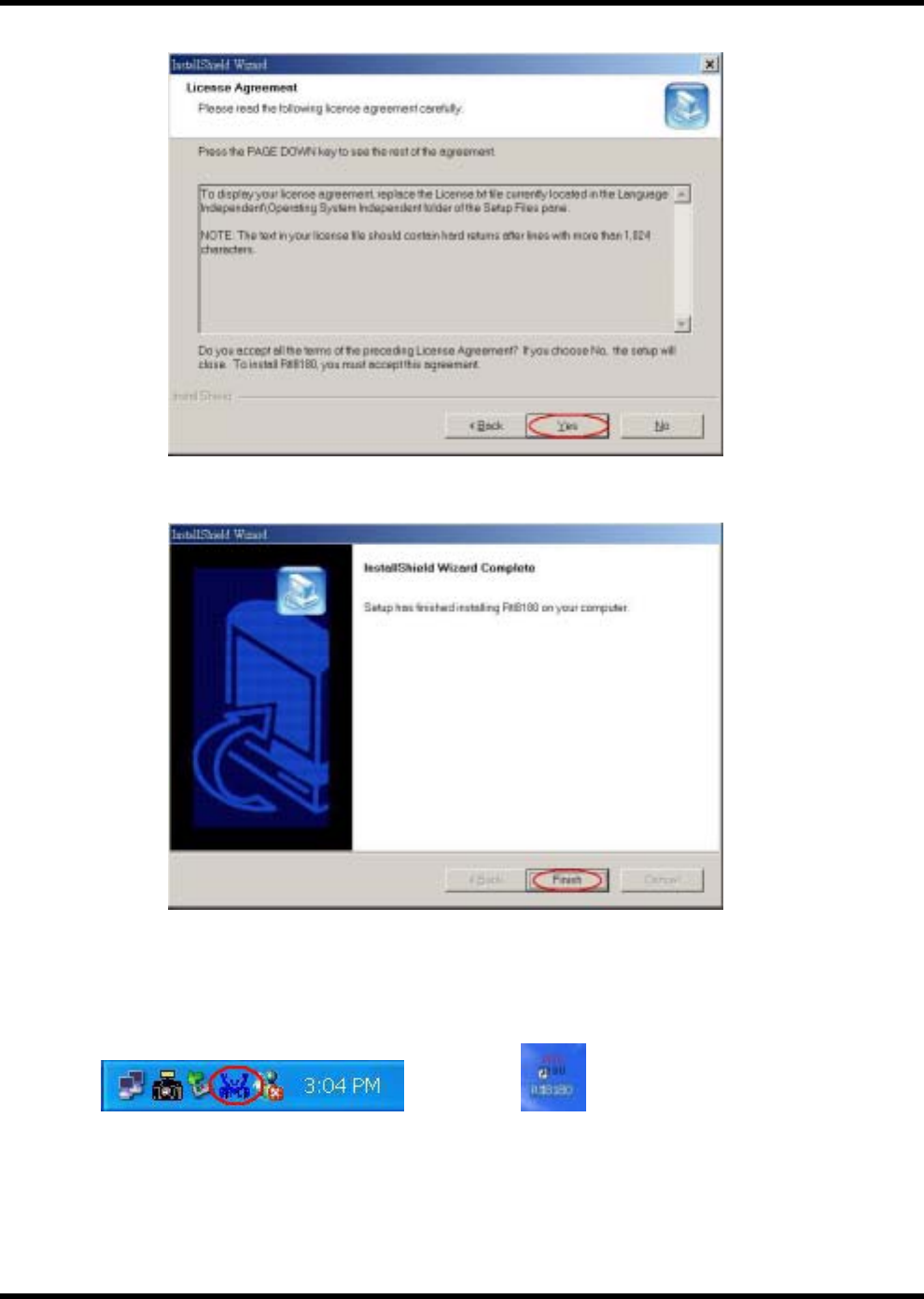
Booming
TwinMOS Page 13
2. Accept the license agreement
3. Click "Finish" to complete the installation.
4. When you complete the Utility installation, a shortcut named “Rtl8180“ will appear in the computer’s
desktop and a new icon will be displayed in the taskbar at the bottom of the screen.
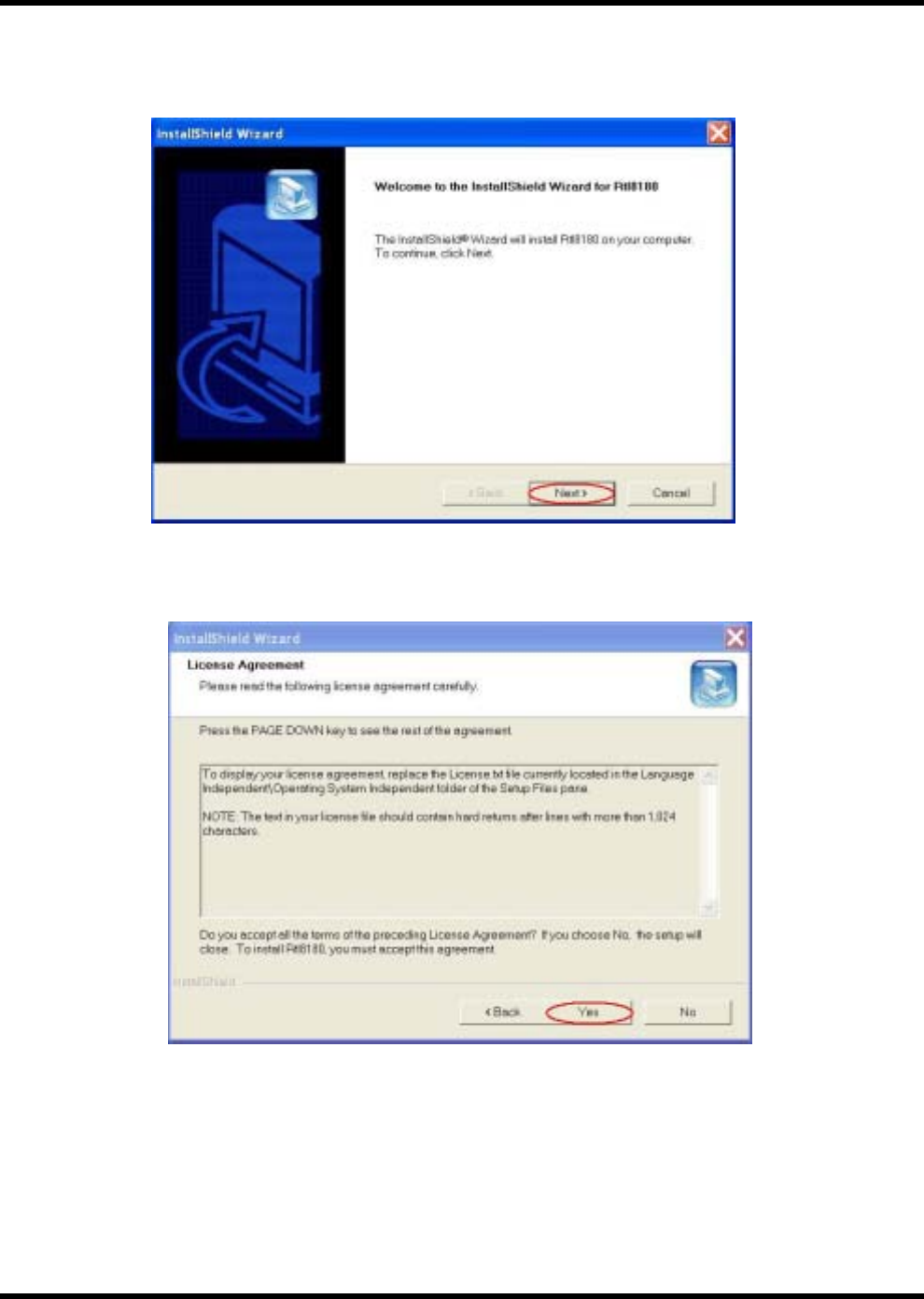
Booming
TwinMOS Page 14
For Windows XP
1. Insert the CD into the CD-ROM device and execute the "Setup.exe" program. The InstallShield
Wizard box will appear, click "Next" to continue.
2. Accept the license agreement.
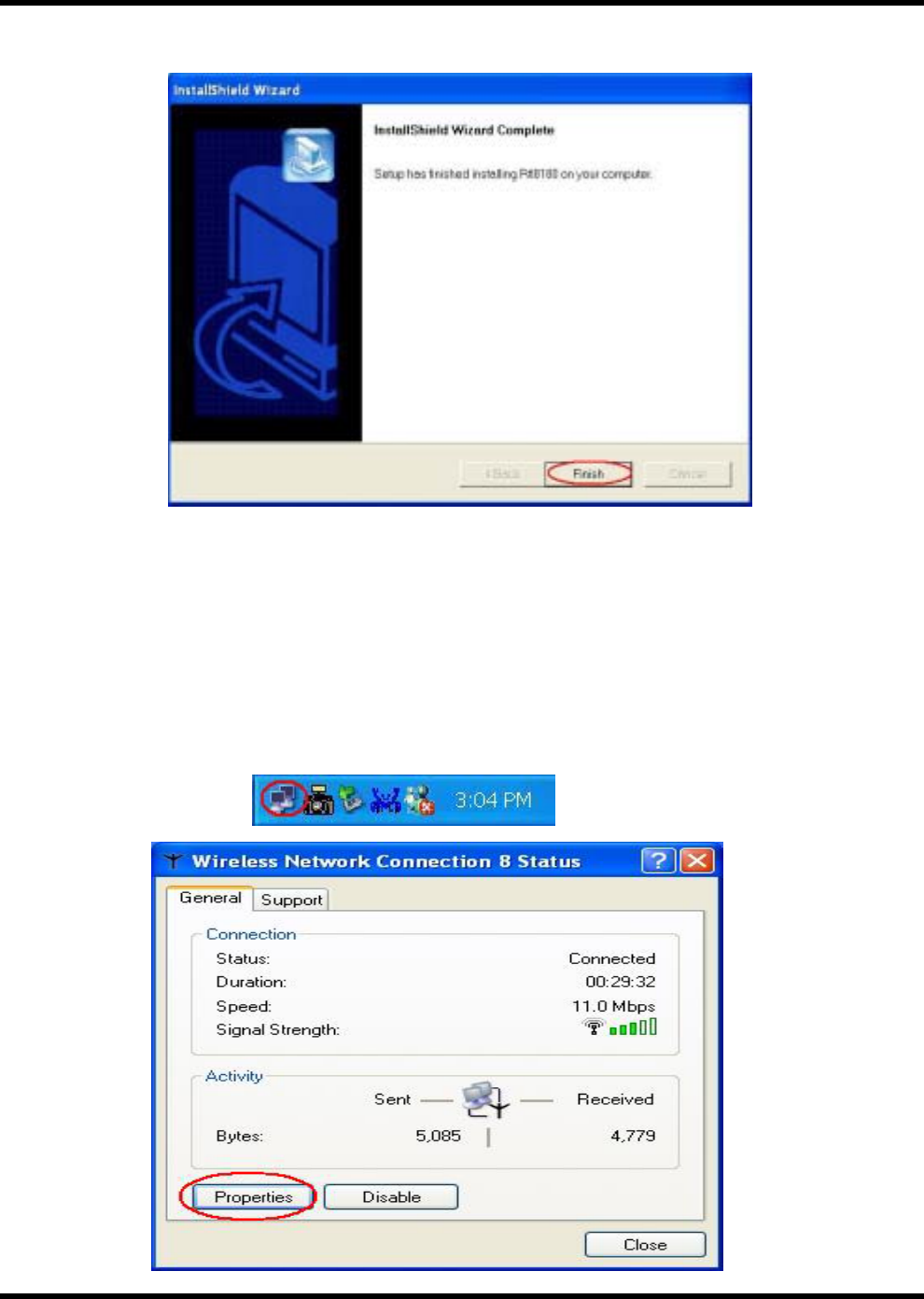
Booming
TwinMOS Page 15
3. Click "Finish" to complete the installation.
4. When you complete the Utility installation, a shortcut named “Rtl8180“ will appear in the
computer’s desktop and a new icon will be displayed in the taskbar at the bottom of the screen.
Using the Windows XP’s Utility
To connect to your wireless network, please do the following:
◎Double-lick the icon marked in red in the taskbar and you may start using the Windows XP’s wireless
utility
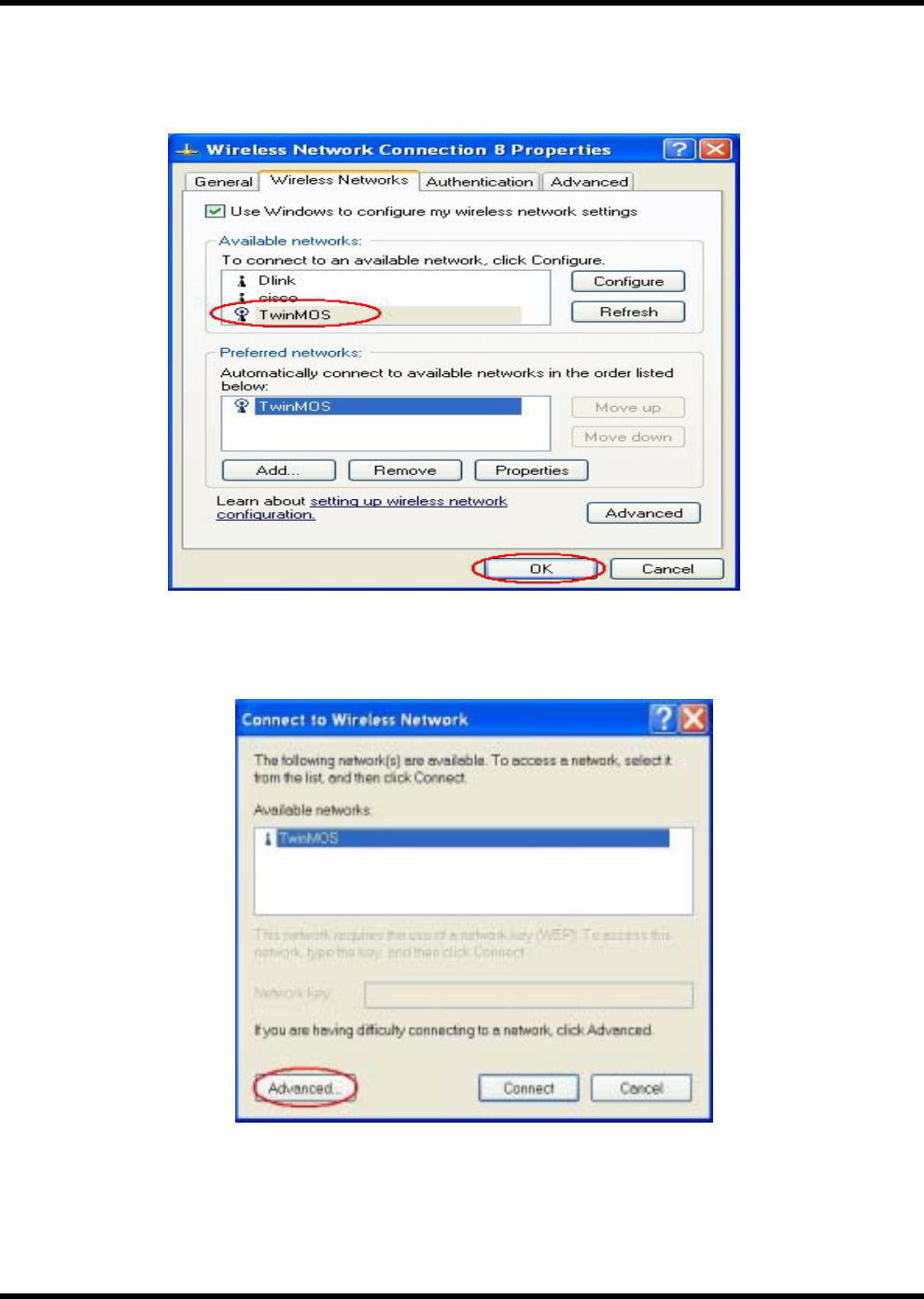
Booming
TwinMOS Page 16
◎ The “Connect to Wireless Network” window will contain a list of all the available Wireless
Networks. Select the proper network for your needs. In this example, “TwinMOS” network was
selected as shown.
Using the Utility of Booming WLAN Card
◎ Get into Windows XP’s Utility, click “Advanced“ button.
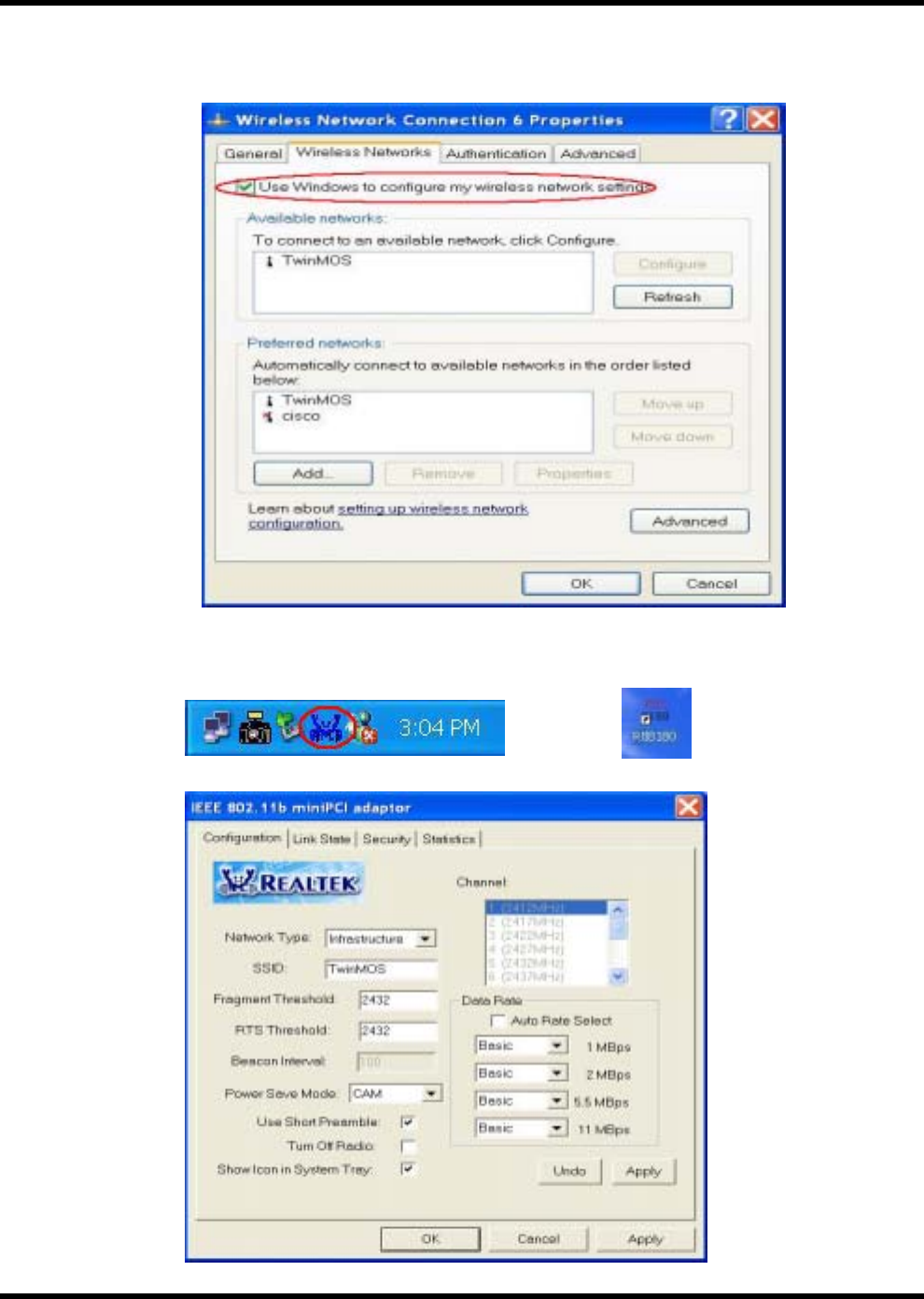
Booming
TwinMOS Page 17
◎In “Wireless Network Connection Properties“ screen, uncheck the setting “Use Windows to configure
my wireless network settings“. Note that if you want to change back to the Windows XP built-in utility,
check the item again.
◎Double click the shortcut or click the icon and start using the WLAN Card .
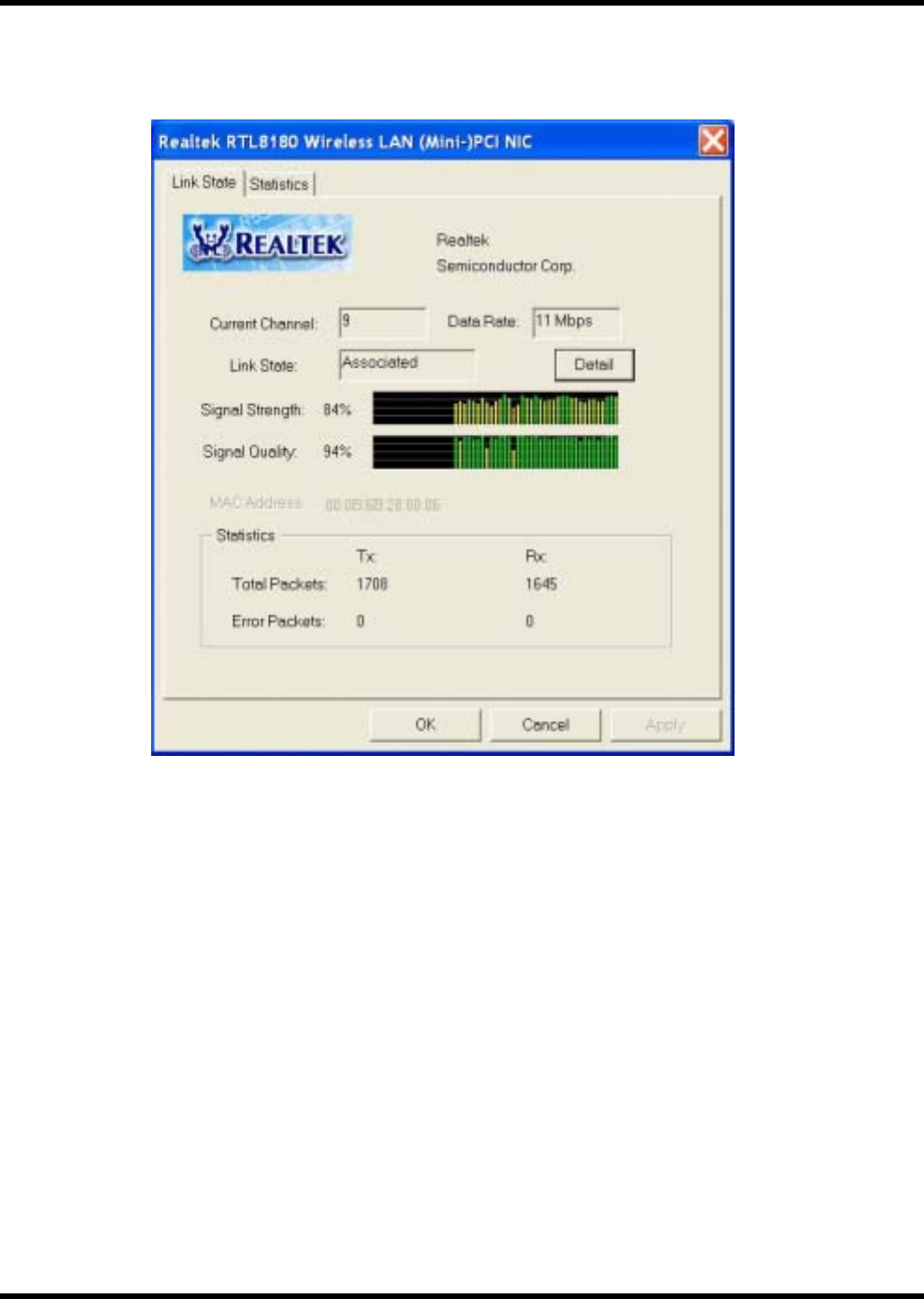
Booming
TwinMOS Page 18
Note: If you don’t disable the XP’s Utility, you can still see the link status and statistics during
communication process from the adapter’s utility.
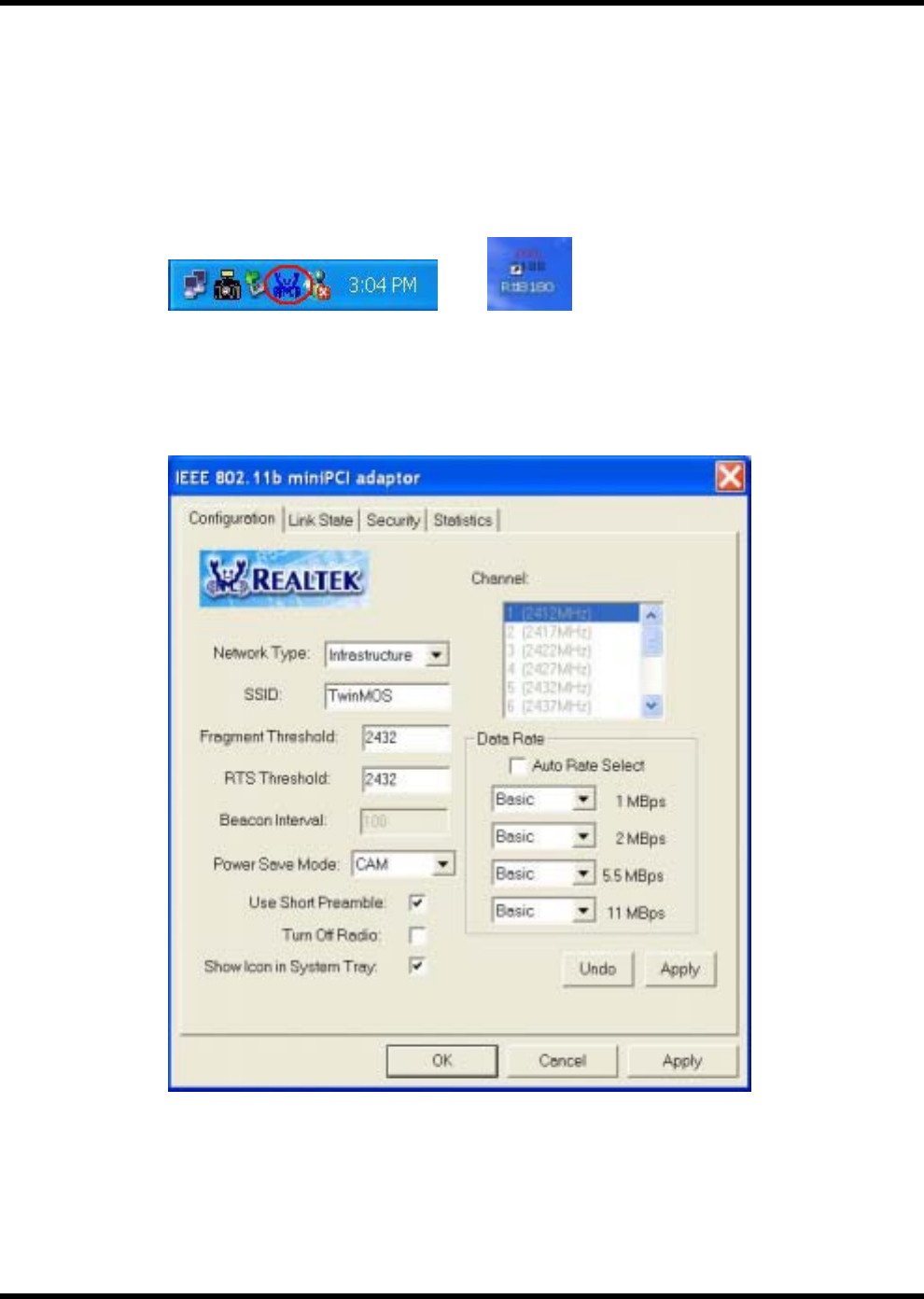
Booming
TwinMOS Page 19
CONFIGURATION UTILITY
TwinMOS Booming WLAN Card uses the Configuration Utility as the management software. The
utility provides the user an easy interface to change any settings related to the wireless adapter. When
the computer is started, the Configuration Utility starts automatically and the system tray icon is loaded
in the toolbar (see illustration below.) Clicking on the utility icon will start the Configuration Utility.
Double-click on the icon shown above. The screen below will be displayed.
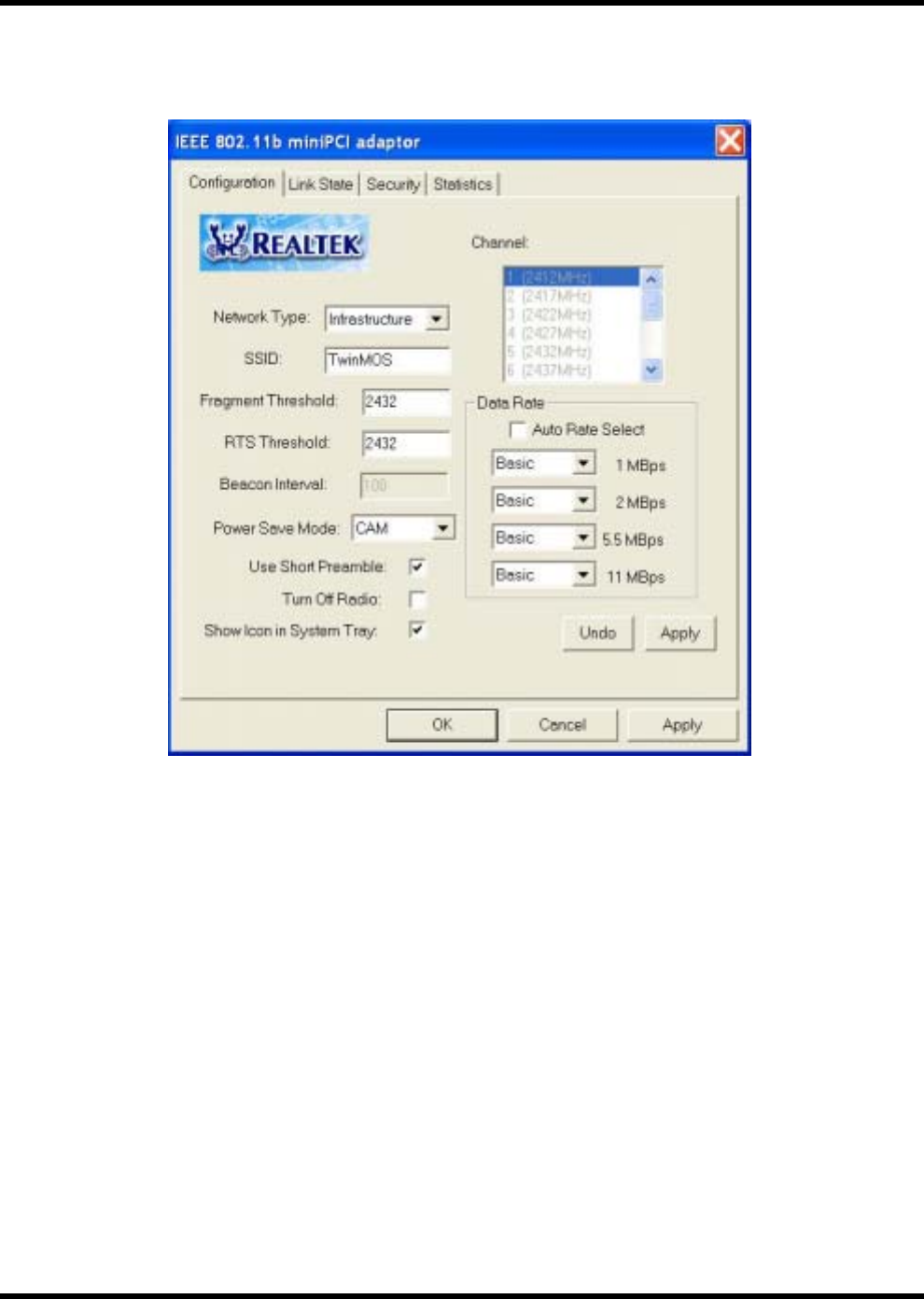
Booming
TwinMOS Page 20
Configuration Tab
Select the Configuration Tab to access the Configuration menu, as shown below. You can make
changes to any of the fields shown below, without the need to restart your computer.
Network Type
The Booming WLAN Card can operate in one of two modes, which are specified in the Mode field of
the Configuration menu. Clicking the down arrow at the right of the Mode field displays the available
modes.
Ad-Hoc - This is the 802.11b Ad-Hoc mode of operation. In “Ad-Hoc” mode, only one wireless
“ cell ” is supported for each different NETWORK NAME. All communication is done from
client to client without the use of an Access Point. “Peer-to-Peer” networking uses the same
NETWORK NAME for the wireless adapters in establishing the network connection. When
“Ad-Hoc ” mode is selected, the utility will provide a selection for setting the channel.
Infrastructure - This mode of operation requires the presence of an 802.11b Infrastructure. All
communication is done through the Infrastructure, which relays packets to other wireless clients
as well as to nodes on a wired Ethernet network.
SSID
The name of the wireless network. This name cannot be longer than 32 characters. The default value is
“any”, which will automatically scan and connect the best performance Access point nearby.You may
specify a SSID for the adapter and then only the device with the same SSID can interconnect to the
adapter.

Booming
TwinMOS Page 21
Fragement Threshold
The value defines the maximum size of packets, any packet size larger than the value will be fragmented.
If you have decreased this value and experience high packet error rates, you can increase it again, but it
will likely decrease overall network performance. Select a setting within a range of 256 to 2432 bytes.
Minor change is recommended.
RTS Threshold
Minimum packet size required for an RTS (Request To Send). For packets smaller than this threshold,
an RTS is not sent and the packet is transmitted directly to the WLAN. Select a setting within a range of
0 to 2432 bytes. Minor change is recommended
Beacon Interval
This value specifies the duration between beacon packets (milliseconds). The beacon packets include the
adapter’s information and are broadcasted to the WLAN network periodly. The beacon period is fixed in
100ms.
Power Save
CAM(Continuous Access Mode) – Adapter will always set in active mode.
Max – Enable the adapter in the power saving mode when it is idle.
Fast – Enable the adapter in the power saving mode when it is idle, but some compoents of
the adapter is still alive. In this mode, the power consumption is larger than “Max“ mode.
Turn Off Radio
When the setting is checked, the wireless connection of the adapter will be disabled.
Use Short Preamble
The preamble defines the length of the CRC block for communication between the Access Point and the
adapter. High network traffic areas should use the shorter preamble type.
Show Icon in System Tray
Enable or disable the icon shown in the taskbar.
Channel
When communicating in Ad-Hoc mode, you must specify a channel on which communications will take
place. This field is grayed in infrastructure mode because the Access Point automatically selects the
channel.
Data Rate
Auto Rate Select- When it is enabled, the device will choose the most suitable transmission rate
automatically.
1, 2, 5.5 ,11 MBps
Not Used- Prohibits the device from operating at the specified data rate.
Used – Allows the device operating at the specified data rate
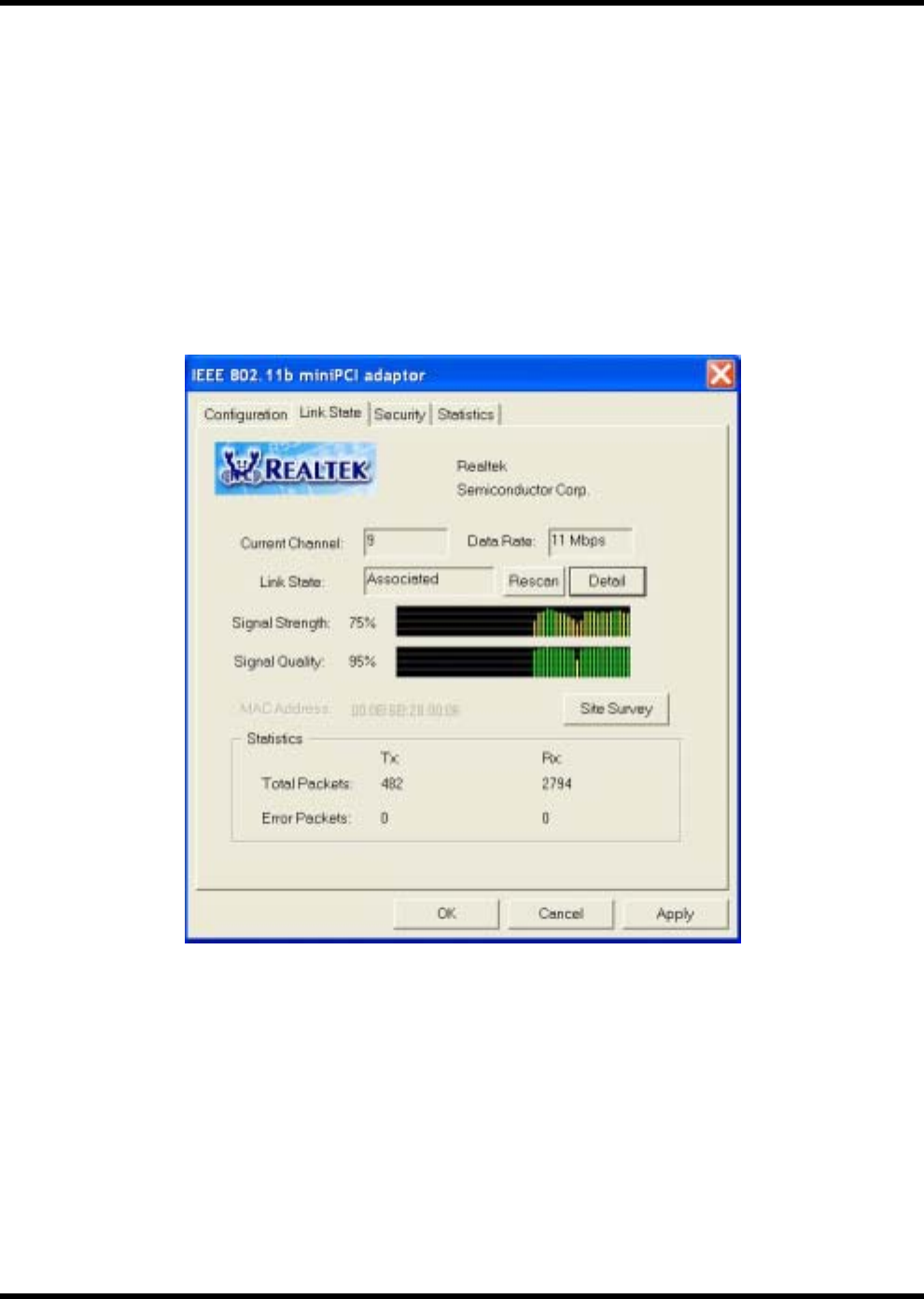
Booming
TwinMOS Page 22
Basic – Restrict the device to operate at least at the specified data rate. At least one kind of data rate has
to be set “Basic“.
Apply
Click “Apply” button to save and implement the new settings.
Cancel
Click “Cancel” button to cancel the modification of the settings.
Link State Tab
The Link State Tab displays the current state of your wireless adapter.
Current Channel
Shows the channel on which the connection is made. In infrastructure mode, this number changes as the
radio scans the available channels.
Link State
Shows the status of the connection.
•Checking Status – Represents the adapter is checking the status of the wireless device.
•Not Associated – Represents the connection is interrupted. You may press “Rescan“ button to
reconnect the wireless device.
•Associated – Represents the adapter is successfully linking to the wireless device.

Booming
TwinMOS Page 23
Data Rate
Shows the highest transmit rate of the current association.
Rescan button
Click this button to scan the Access Point or Adapter which the adapter connected before or intends to
connect.
Detail
A screen will appear when you press the button. In this screen, you may see all the parameters of the
adapter and also the link status.
Signal Quality
This bar indicates the quality of the link. The higher the percentage, the better the quality.
Signal Strength
This bar shows the signal strength level. The higher percentage shown in the bar, the more radio signal
been received by the adapter. This indicator helps to find the proper position of the wireless device for
quality network operation.
MAC Address
Shows the MAC Address of the adapter.
Statistics
Shows the total amounts of data packets that have been successfully/unsuccessfully transmitted or
received by the adapter.
Site Survey button
This screen shows all Access Points or Adapters nearby when operating in Ad-Hoc mode. Click
“Refresh” button to collect the SSID and Channel information of all the wireless devices nearby. If you
want to connect to any device on the list, double-click the item on the list, and the adapter will
automatically connect to the selected device.
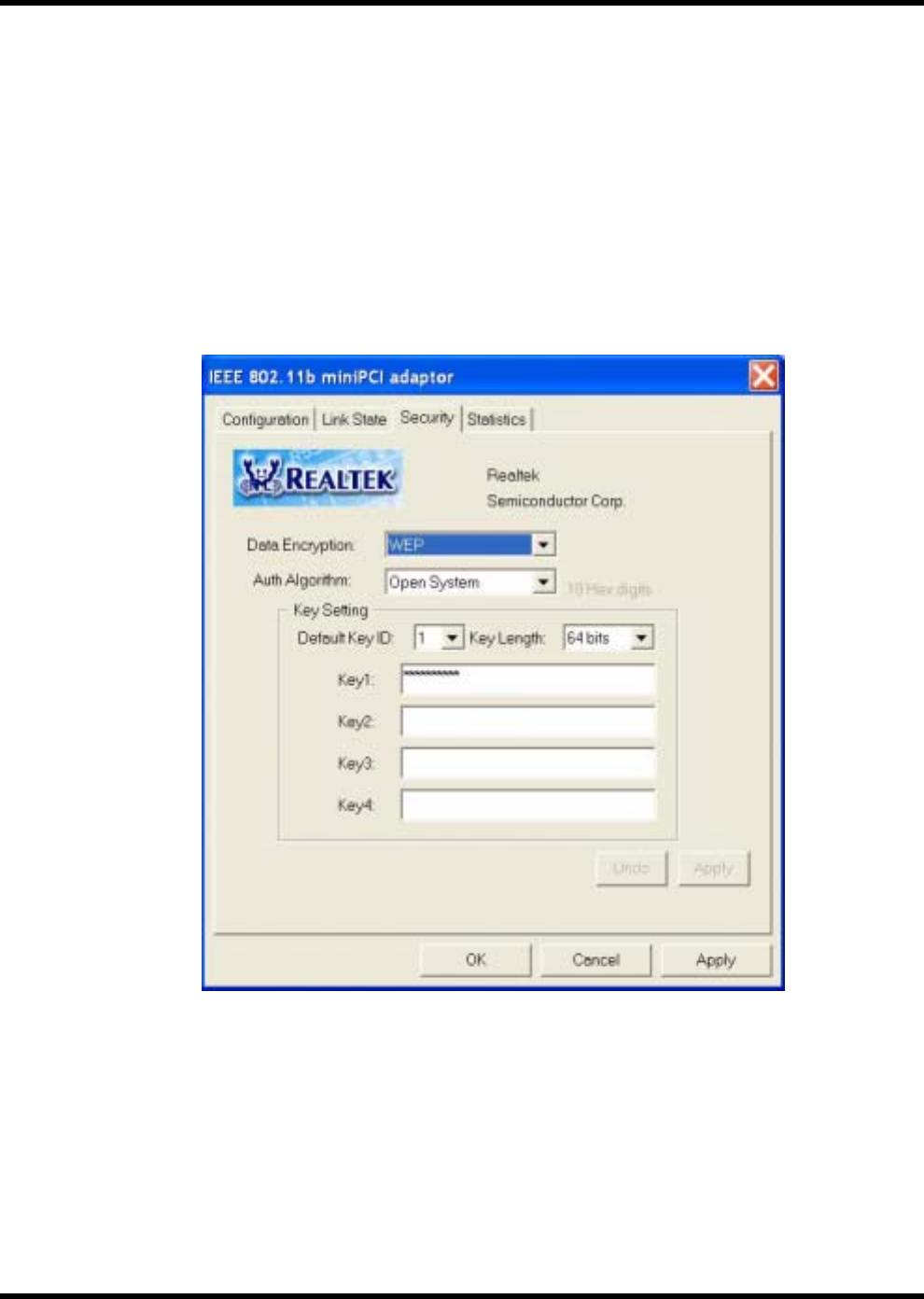
Booming
TwinMOS Page 24
Security Tab
“Security” tab allows you to enhance the security of a network. Every station in a secured network
should enable the Encryption function and the values of the Network Key should be the same.
WEP is an authentication algorithm, which protects authorized Wireless LAN users against
eavesdropping. WEP has been found that it has some security problems. TKIP is a temporary quick-fix
method defined in IEEE 802.11i standard to quickly overcome the inherent weaknesses in WEP security.
AES has been developed to ensure the highest degree of security and authenticity for digital information
and it is the most advanced solution defined by IEEE 802.11i for the security in the wireless network.
Data Encryption
•No Encryption – Disable the WEP Data Encryption.
•WEP – Enable the WEP Data Encryption. When the item is selected, you have to continue setting the
WEP Key Length and the encryption keys.
•Realtek TKIP – Enable the TKIP Data Encryption. When the item is selected, you have to continue
setting the TKIP Key Length and the encryption keys.

Booming
TwinMOS Page 25
•Realtek AES – Enable the AES Data Encryption. When the item is selected, you have to continue
setting the AES Key Length and the encryption keys.
Auth Algorithm
This setting has to be consistent with the wireless devices which the adapter intends to connect.
•Open System – No authentication is needed among the wireless devices.
•Shared Key – Only wirelss devices using a shared key (WEP Key, TKIP Key or AES Key identified)
are allowed to connecting each other. Setup the same key as the wireless devices which the adapter
intends to connect.
•Auto Switch – Auto switch the authentication algorithm depending on the wireless devices which the
adapter is connecting to.
Default Key ID
Select one of the keys (1~4) as the encryption key.
Key Length
You may select the 64-bit or 128-bit to encrypt transmitted data. Larger key length will provide higher
level of security, but the throughput will be lower.
Key1~Key4
The keys are used to encrypt data transmitted in the wireless network. Fill the text box by following the
rules below.
•64-bit – Input 10 digit Hex values (in the “A-F”, “a-f” and “0-9”range) as the encryption keys. For
example: “0123456aef“.
•128-bit – Input 26 digit Hex values (in the “A-F”, “a-f” and “0-9” range) as the encryption keys. For
example:“01234567890123456789abcdef“.
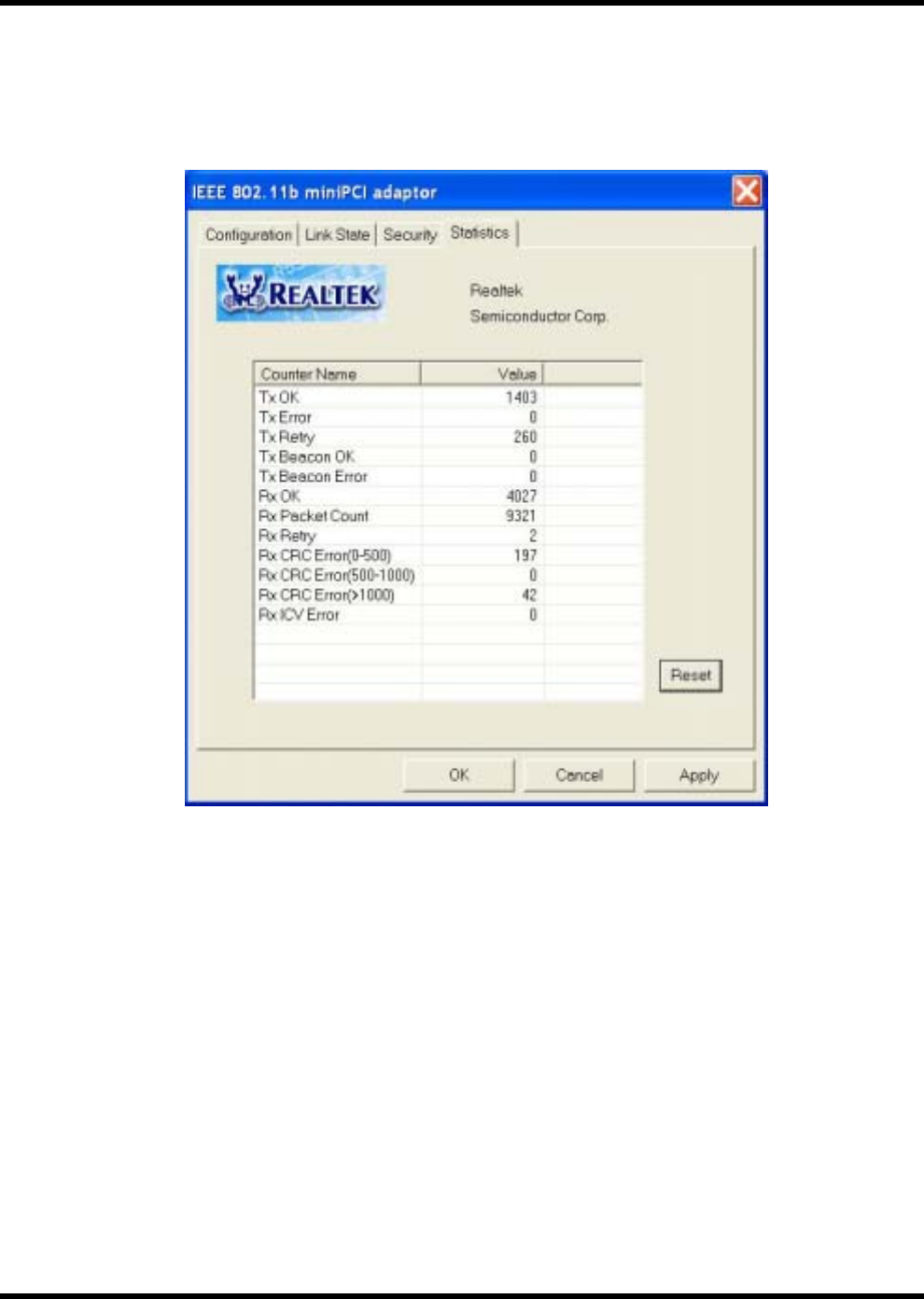
Booming
TwinMOS Page 26
Statistics Tab
In the “Statistics”, you can get the real time information about the packet transmission and receiving
status.

Booming
TwinMOS Page 27
TROUBLESHOOTING
If you encounter some problems while installing the Booming WLAN card or you want to confirm
whether your adapter is installed properly or not, we have listed the procedure for checking the various
components after you have installed the adapter. In first part of Troubleshooting, we have suggested the
users to check the various properties of the card to check the proper installation. In second section, we
have listed the various problems that you may encounter during the installation and have also listed the
possible solution. Check the first part to guess the probable reason of unsuccessful installation.
Please check the followings if you encounter some problem while installing the Booming WLAN Card
or yours Booming WLAN Card are non-functional.
In Windows 2000:
To check that the Booming WLAN Card is installed properly, please do the following:
1. Check the Windows 2000 Diagnostics. See if there is any conflict in the Resource allocation or the
I/O Address, IRQ allocations. If you find that the IRQ or I/O Addresses are already assigned to some
other devices, you must change that value.
2. Go to the Control Panel. Double click on the Network Adapter, you will see Booming WLAN Card.
Double clicking on that will show you the status of the Booming WLAN Card. If there are no error
signs, the adapter has been installed properly.
In Windows XP:
To check that the Booming WLAN Card is installed properly, please do the following:
1. Go to START>CONTROL PANEL. Double-click on Network Connections. Right-click on LAN.
Click Properties.
2. The Booming WLAN Card will appear, indicating proper installation.

Booming
TwinMOS Page 28
TECHNICAL SPECIFICATIONS
Networking Characteristics
Compatibility IEEE 802.11 Standard for WLAN (DSSS)
Internal Wi-Fi certified by TwinMOS
Host OS Windows 98/98SE/ME/2000/XP/Linux
Media Access Protocol CSMA/CA with ACK
Network Protocol TCP/IP, IPX, NetBEUI
RF Characteristics
Frequency Range 2.400-2.4835 GHz, Direct Sequence Spread Spectrum (DSSS)
Operating Channels
1-11 United States (FCC)
1-11 Canada (DOC)
1-14 Japan (MKK)
1-13 Europe (Except Spain and France) (ETSI)
Modulation Technique
11 Mbps: CCK
5.5 Mbps: CCK
2 Mbps: DQPSK
1 Mbps: DBPSK
Spreading 11-chip Barker Sequence
Transmit Power 14 dBm @ Nominal Temp Range
Receive Sensitivity Nominal Temp Range:11 Mbps 10-5 BER @ -84 dBm, minimum
Security
64/128-bit WEP Encryption
64/128-bit TKIP Data Encryption
64/128-bit AES Data Encryption
Operating Range Open Space:100 ~ 300m; Indoor: 30m ~ 100m
The transmission speed varies in the surrounding environment.
EMC Certification FCC Class B part 15B, 15C; R&TTE

Booming
TwinMOS Page 29
NOTE
This equipment has been tested and found to comply with the limits for a Class B digital
device, pursuant to Part 15 of the FCC Rules. These limits are designed to provide reasonable protection.
This equipment generates, uses and can radiated radio frequency energy and, if not installed and used in
accordance with the instructions, may cause harmful interference to radio communications. However,
there is no guarantee that interference will not occur in a particular installation If this equipment does
cause harmful interference to radio or television reception, which can be determined by turning the
equipment off and on, the user is encouraged to try to correct the interference by one or more of the
following measures:
-Reorient or relocate the receiving antenna.
-Increase the separation between the equipment and receiver.
-Connect the equipment into an outlet on a circuit different from that to which the receiver is connected.
-Consult the dealer or an experienced radio/TV technician for help.
Changes or modifications not expressly approved by the party responsible for compliance could void the
user‘s authority to operate the equipment.
This device is sold to OEM integrators only. OEM integrators must be instructed to ensure that the end
user has no manual instructions to remove or install the device.
This device and its antenna(s) must not be co-located or operating in conjunction with any other antenna
or transmitter.
CAUTION: This device is not authorized to be integrated and used in PDAs, hand-held devices, laptops,
or any portable devices, as a separate FCC equipment authorization must be obtained to address RF
exposure (SAR) requirements for portable devices into which this module is installed. The device is
ONLY approved to be integrated and used in mobiles devices (e.g. Access Point), as defined under Part
2.1091.
Installation: the antenna installs at two coners of panel.